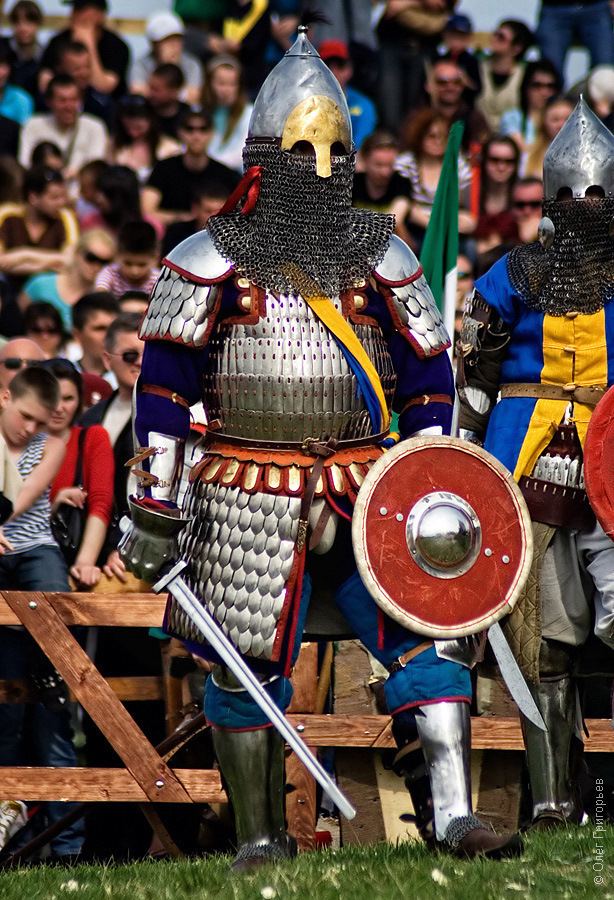 | ||
The Battle of the Nations is an international historical medieval battles world championship, first held in 2009, in Kharkiv, Ukraine and held in Europe, in April, every year since.
Contents

It is a full contact competition using metal weapons and a standardized list of rules. National teams compete in several standard events, with all being full contact - no stage reenactment battles are included.
Teams from up to 25 countries have entered the tournaments.
Main Provisions
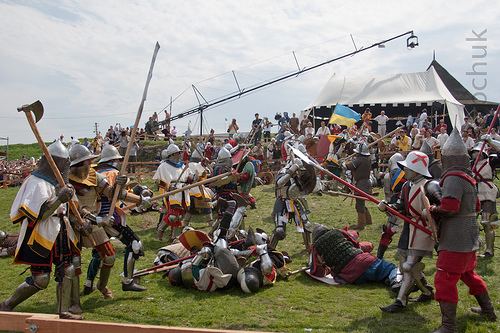
National teams of different countries compete at “Battle of the Nations”. Under the rules of BN, a national team has to consist of at least 8 and a maximum of 50 fighters. Any representative of any of the HMB clubs , as well as an individual fighter, provided he has gone through a selection process conventional for a country, can become a member of a national team.
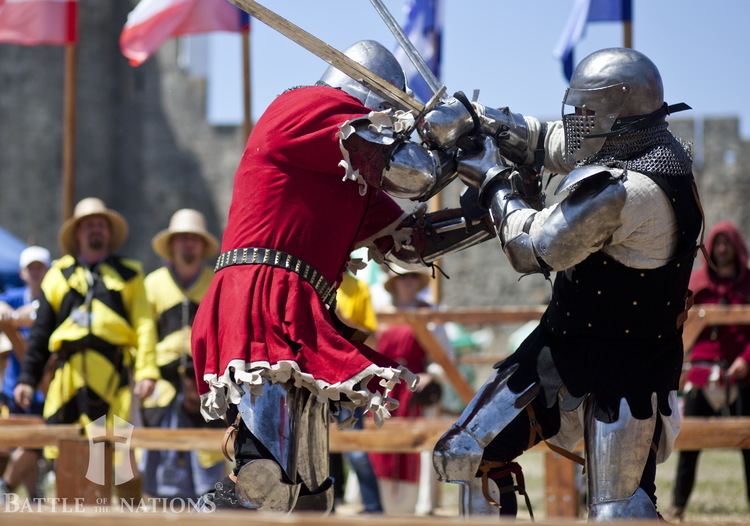
Qualifying tournaments are competitions, where battles are held in accordance with the unified international rules for the historical medieval battle. National teams organize qualifying tournaments to find the best HMB fighters of a country. The unified international rules, according to which battles are held, have been written especially for "Battle of the Nations”. Before the unified rules were written, the countries had different HMB rules.
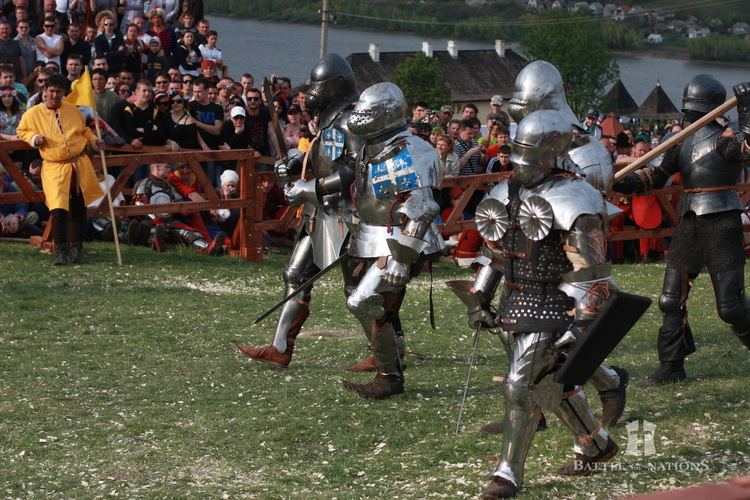
The tradition for this combat/competition has largely come from Russia, where enthusiasts have held previous events where full contact "battles" of large numbers of armoured combatants, are held, often in historical sites. The emphasis is put on the combatants wearing historically accurate equipment and heraldry, and the use of appropriate weapons for the combat.
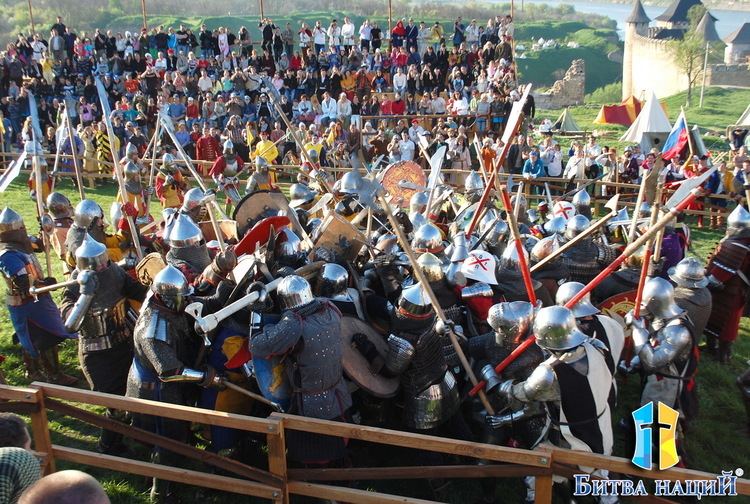
The heraldry, however, reflects the modern competition teams, rather than necessarily historically correct heraldic device that may have been worn by combatants in the medieval period. The first tournament was held at the Khotyn Fortress in Ukraine in 2010. The combatants depict armoured fighters from the 12th - 15th century. A number of different forms of combat take place, including some involving individuals, 5 a side or 21 on each side. Over 200 armoured men at arms take place in the competition, and in addition to melee/hand-to-hand weapons, archery is also featured.
Team Quebec (also known at Ost du Quebec) was the first non-European team to enter the tournament in Ukraine in 2011. Their captain put a team together of 9 fighters and 3 support staff who traveled from Montreal Quebec to take part in the tournament. They also held the first friendly tournament under the HMB rules in St-Eustache in February 2012 where participants from Ontario and USA took part. Together with Scallagrims group from Toronto they founded the National Medieval Martial Arts League in Canada.
US combatants entered a team for the first time in 2012, with a number of their members coming from the Society for Creative Anachronism. The US team is a cross-group association of historic martial arts organizations.
"Battle of the Nations 2012" gathered participants from 12 countries.
By the following year, that number increased to 22 teams which participated in the "Battle of the Nations 2013", which was held in Aigues-Mortes in southern France. This was the first time the event was held outside east Europe.
"Battle of the Nations 2014" took place on 12 June in Trogir, Croatia. This was the year of the first female official nomination in the fencing "Triathlon". An innovation for the championship.
"Battle of the Nations 2015" was held in Prague, Czech Republic, 7–10 May. The women's buhurt category: all vs all - was promoted to be the innovation for that year's championship.
List of participants (Sorted by first-year participation):
2010 — Russia, Ukraine, Belarus, Poland 2011 - Germany, Italy, Canada 2012 - Austria, United States, Israel, Denmark, The Baltic States- union of Lithuania, Latvia, Estonia 2013 - Argentina, Australia, Belgium, Czech Republic & Slovakia, France, Japan,Luxembourg, New Zealand, Spain, United Kingdom Fighters from Portugal also attended, and fought with the Luxembourg team. 2014 - Chile, Netherlands, Finland, Switzerland.
About 25,000 attend the event annually.
History
The first meeting for the organization of the festival and the championship was held in Kharkiv in 2009. Its participants, captains of the first national teams, came to a consensus concerning how to hold the event. Since the rules could vary in different countries and even in different regions of one country, they also agreed of a set of unified international rules for the conduct of battles.
The first "Battle of the Nations" event was held in 2010 in Khotyn (Ukraine). It was attended by the national teams of four countries: Russia, Ukraine, Belarus, Poland. Russia won most of the first places. The program included three categories: a duel (1 vs 1), group battles (5 vs 5) and mass battles (21 vs 21). For those who were not members of the national teams, but came to support the comrades, there were non-security buhurts.
The second event, in 2011, was also held at the Khotyn Fortress. seven national teams participated; the previous four and three novice teams: Italy, Germany, Quebec. Two more categories were added to the three classic ones, namely the “professional fight” and “all vs all”. The latter category allows participants who are not members of the national teams to fight for their countries. The first places were won by Russia. The festival was attended by about 30,000 spectators and a documentary about the life of the participants was shot.
The 2012 event was held in Warsaw, Poland, and included representatives of twelve countries. A feature of the festival were battles of mounted knights, that were included in the program of the traditionally foot world championship in HMB for the first time. The top four teams were Russia, Ukraine, Poland, and USA.
Battle of the Nations 2013 was held in Aigues-Mortes, France. Twenty-two teams from Europe, the Americas, and the Pacific Rim took part. With the increase of teams, there were no "pro rules" fights or mounted jousting in the main arena. The top four teams were Russia, Ukraine, Belarus, and USA.
Trogir, Croatia was the venue for the 2014 event. Around 30 countries were expected.
The 2015 event was held in Prague.
The seventh event, in 2016, was also held in Prague. 35 countries were expected.
Valid battle categories
Valid battle categories of the competitions held among national teams on the HMB and a brief explanation of them:
Valid non-battle categories
